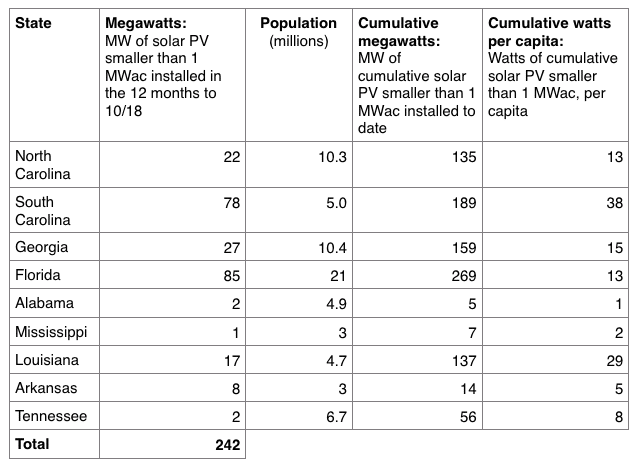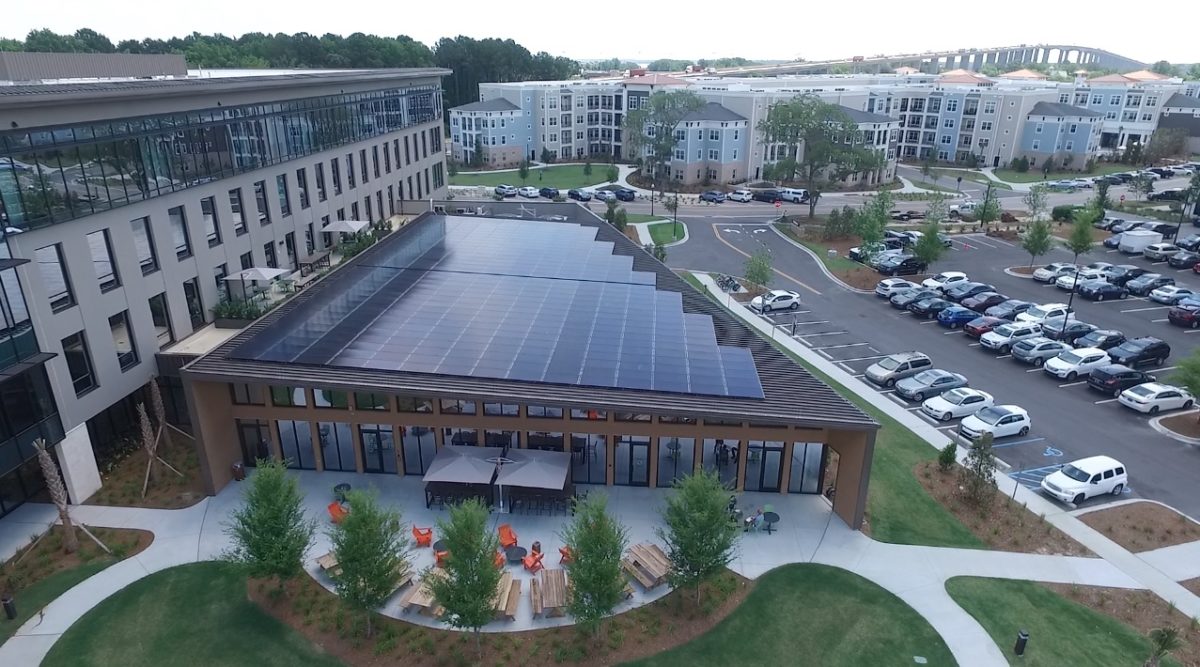Solar installation crews in the Southeast put up 242 MW of small-scale (under 1 MW) solar PV systems in the year to October 2018.
Florida added 85 MW, edging out South Carolina at 78 MW. But South Carolina leads on a population-weighted basis, having widened its lead over Louisiana in second place.
This year, 3.9 GW of distributed generation is projected to come online nationwide—nearly as much as utility-scale generation—according to the Energy Information Administration (EIA).
Here are the data for nine Southeastern states, from EIA’s Form EIA-861M reports for small-scale solar:

Policy goals
Policy experts in the region offered their goals for advancing distributed solar in the coming year:
- North Carolina: Rooftop solar rebates recently “sold out” in two days for residential customers, said David Rogers of the Sierra Club. This year the group aims to “ensure that all rooftop rebates are maximized, and defend against any attacks on the state’s net metering policy,” he said.
- South Carolina: “We are supporting the comprehensive solar legislation proposed in South Carolina,” said Bryan Jacob with the Southern Alliance for Clean Energy, referencing S.332 and H.3659. Vote Solar sees “this Republican-led bill” as a “huge opportunity to move solar forward,” in the state, said Thad Culley with the organization. David Rogers of the Sierra Club noted that Duke Energy has already hit the net metering cap, and said his group will “fight Duke’s effort to triple the mandatory fixed charges on customers’ bills.”
- Tennessee: “TVA’s recent policies have sought to minimize distributed generation,” said Gil Hough with TenneSEIA. He said the group is working to achieve consumers’ desire for solar choice, through policies that provide municipal and electric cooperatives “the flexibility and tools to serve those customers best.”
- Alabama: A “standby charge” is the reason there’s little distributed generation in Alabama, said Jeff Cantin of the Gulf States Renewable Energy Industries Association (GSREIA). He noted that a regulatory proceeding relating to the charge was to be decided soon by the Alabama Public Service Commission.
- Region-wide: GSREIA will focus on net metering policy, as well as solar tax credit proposals in Mississippi, while it also engages on integrated resource plans across the region, said staff member Stephen Wright. “Our goal is the development of evidence-based renewable policies that have been successful in other areas of the Gulf South, such as Georgia,” he said. Sara Baldwin with the Interstate Renewable Energy Council added that the Southeast needs interconnection procedures that ensure fair, efficient and affordable access to the grid.
A recent report on solar “maker and braker” utilities in the Southeast, by the Southern Environmental Law Center, reviewed the region’s solar policies.
Snapshot stories
Here are the “snapshot stories” provided by solar installation firms, presenting projects from the past year:

Image: Solar & Renewable Power Systems


Image: Sunpro Solar

Image: Solar Alternatives

Image: Aero Drone Images

Image: Don Zimmerman, Alder Energy Systems

Image: Scott Noethen, Appalachian Renewable Resources

Image: Emerald Energy

Image: Cape Fear Solar Systems
Help us learn more about you so we can bring you better news! Click here to take the pv magazine USA reader survey.
This content is protected by copyright and may not be reused. If you want to cooperate with us and would like to reuse some of our content, please contact: editors@pv-magazine.com.








By submitting this form you agree to pv magazine using your data for the purposes of publishing your comment.
Your personal data will only be disclosed or otherwise transmitted to third parties for the purposes of spam filtering or if this is necessary for technical maintenance of the website. Any other transfer to third parties will not take place unless this is justified on the basis of applicable data protection regulations or if pv magazine is legally obliged to do so.
You may revoke this consent at any time with effect for the future, in which case your personal data will be deleted immediately. Otherwise, your data will be deleted if pv magazine has processed your request or the purpose of data storage is fulfilled.
Further information on data privacy can be found in our Data Protection Policy.